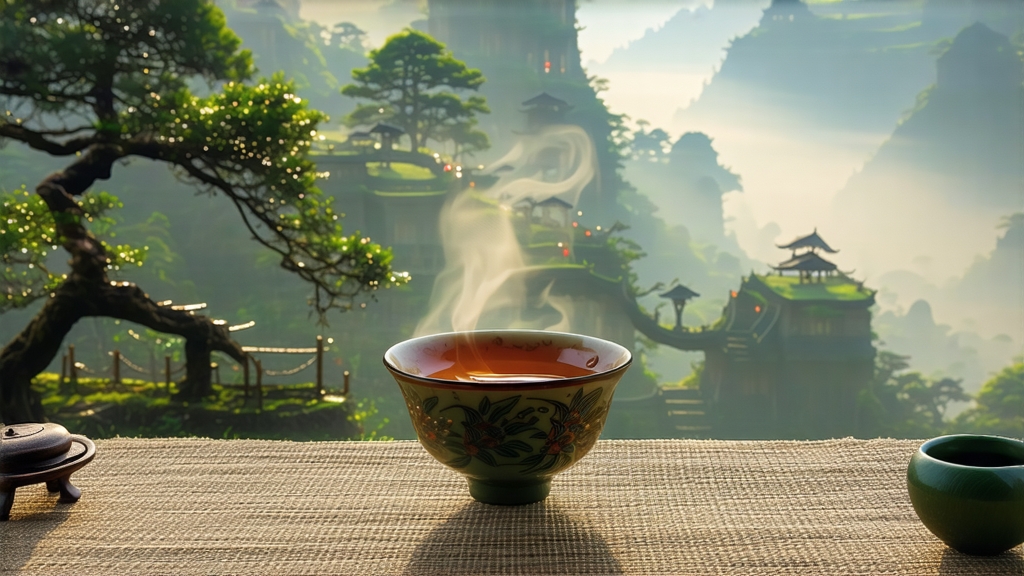
High above the subtropical plains of eastern Guangdong, the Phoenix Mountains (Fenghuang Shan) rise in a procession of granite spires and cloud-veiled ridges. Here, between 350 m and 1,300 m elevation, grow some of the oldest cultivated tea trees on earth—arboreal giants whose roots have clung to mineral-rich slopes since the Song dynasty. From these venerable plants comes Phoenix Dancong, an oolong family so perfumed and articulate that Chinese connoisseurs call each individual tree a “single bush song.” No other oolong carries such a repertoire of natural aromas—orchid, lychee, almond, ginger flower, ripe mango—yet all are born from the same landrace cultivar, Camellia sinensis var. sinensis ‘Shuixian’ type, locally mutated over centuries.
The written record begins in 905 CE, when Tang-dynasty scholar Mao Wenxi noted “fragrant leaf tea from Fengzhou” presented at the imperial court. By the Southern Song (1127–1279), tribute lists specify “Phing Hung” (early Cantonese for Phoenix) cakes pressed for Emperor Xiaozong. Farmers discovered that when individual trees were isolated, their leaf chemistry intensified; thus the practice of dan zhu—single-tree harvesting—took hold. During the Ming, itinerant monks from Fujian brought with them the half-oxidation technique now synonymous with oolong, marrying Wuyi craftsmanship to Guangdong’s genetic treasure chest. The Qing Qianlong Emperor (r. 1735–96) so adored the honeyed cup that he exempted Phoenix tea from salt taxes, embedding it in Lingnan folk memory as “the drink that saved the prefecture.”
Today more than eighty aromatic profiles are catalogued, yet only ten “mother fragrances” are commercially prominent. Mi Lan Xiang (Honey-Orchid) remains the ambassador, its cup dripping with tropical flowers and longan sweetness. Huang Zhi Xiang (Gardenia) offers a greener, high-toned bouquet reminiscent of white florals after rain. Xing Ren Xiang (Almond) surprises with a marzipan creaminess anchored by rocky minerality. Jiang Hua Xiang (Ginger Flower) sparks with spicy top notes that dissolve into candied pear. Finally, the revered Song Zhong, cloned from a 700-year-old tree planted during the Song era, layers dried apricot, sandalwood and a cooling menthol finish that lingers like a mountain breeze. Each profile is not flavored but genetically expressed, the result of micro-climate, altitude, age, and the charcoal finishing that is the signature of Chaozhou craftsmen.
Making Phoenix Dancong is a dialogue between urgency and patience. Picking occurs only in late April, when two leaves and a bud are still modest in size yet already redolent. The morning’s pluck must reach the village workshop by noon; there, the first of five sun-withering turns begins on bamboo trays set at 28 °C. Leaves lose roughly 10 % moisture, softening cell walls for the critical bruising stage. In a courtyard perfumed by osmanthus, experienced “shake masters” toss 3 kg batches into the air, letting the mass crash onto rattan racks. Edge cells rupture, triggering oxidative enzymes that will paint the leaf edges a coppery red while the center stays jade green. Oxidation is arrested at 30–35 % by a 260 °C tumble in gas-heated drums—hot enough to fix fragrance yet brief enough to preserve volatile aromatics.
What follows is the craft that separates Dancong from all other oolongs: three successive charcoal bakes, each cooler and longer than the last. Using only local longan wood, artisans pile embers into pyramids, cover them with a 5 cm ash blanket, and lower temperature to 80 °C for the first 2-hour session. Leaves rest 48 hours, then return to 60 °C for four hours, and finally 45 °C for six. Between bakes, tea is hand-sorted to remove broken bits; the goal is a strip so intact it can stand upright when brewed. This low, radiant heat polymerizes sugars, creating caramelized compounds that lock in mountain florals while adding a whisper of smoked honey. The entire cycle stretches 20 days, after which the tea slumbers in earthen jars for at least three months so residual fire quiets into rounded sweetness.
To unlock the song, one must brew with the precision of a chamber musician. Chaozhou